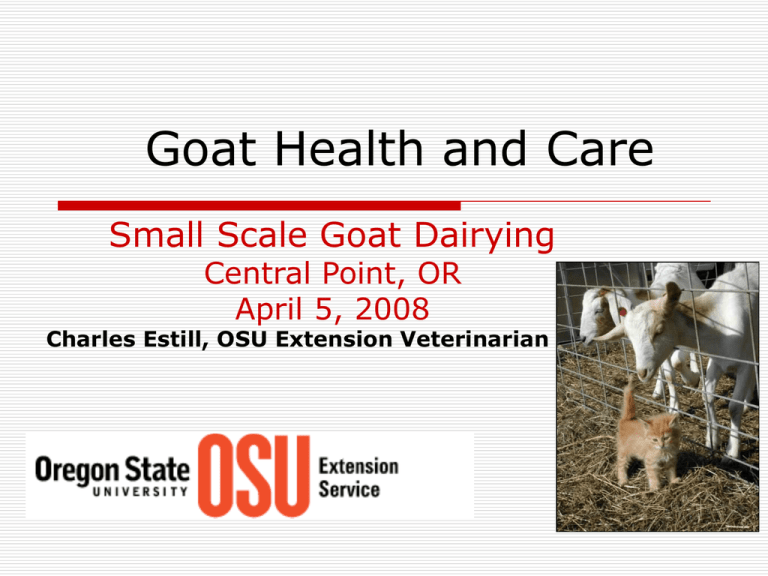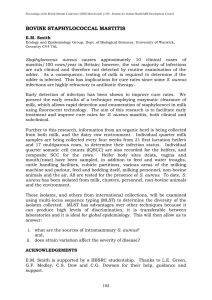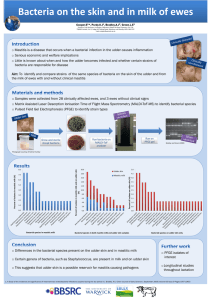Charles Estill Presentation
advertisement

Goat Health and Care Small Scale Goat Dairying Central Point, OR April 5, 2008 Charles Estill, OSU Extension Veterinarian Biosecurity Security from transmission of infectious diseases, parasites, and pests Buy from reputable breeders. Know the health status of the animals you are purchasing. Maintain a closed herd. Limit showing/ exhibiting. Isolate new animals for at least 30 days. Biosecurity Reduce transmission of infectious diseases, parasites, and pests Don’t loan or share or bucks.* Don’t breed does for other producers.* Do not mix your animals with other people’s animals.* Don’t share equipment unless it is disinfected after each use. Limit access to your farm/animals. Control cat, dog, bird, and rodent populations. *Unless the other farm/animals have equal health status. Health problems of goats Udder disorders Caprine Arthritis Encephalitis Caseous Lymphadenitis Floppy Kid Syndrome Johne’s Disease Mastitis What is a normal udder? Uniformly soft and symmetric Temperature is same as rest of body No swelling or pain Teats are thin and uniform, milk easily Examine milk for: Color Consistency Clots, flakes Diagnosis of mastitis Physical signs Uneven udder Udder is hot, swollen, or painful Sick, off feed, fever Reduced milk production May be no outward signs General types of mastitis Acute Bluebag Sub-clinical Chronic Acute mastitis Udder is hot, swollen, painful Udder may be hard Milk is abnormal (clots, flakes, watery) Reduced milk production Goat may be sick and have a fever May have a stiff gait Can be fatal Blue bag Mastitis caused by Staph. aureus or Pasteurella Up to 80% die Udder is initially red and hot then turns blue and cold Milk is watery, brown May slough ½ of udder Sub-clinical mastitis Very common May be difficult to detect without CMT Udder may be firm May be occasional clots, flakes Reduced milk production Chronic mastitis It is 15 to 40 times more prevalent than the clinical form. It usually precedes the clinical form. It is of long duration. It is difficult to detect. It reduces milk production. It adversely affects milk quality. Firm, nonpainful udder Career counseling Diagnosis of mastitis Testing California mastitis test pH Cells 0, Trace or 1+ is normal Compare halves of udder Somatic cell count (inaccurate) <500,000 is normal (1M reg. limit) Much higher at end of lactation Milk culture Technique Staph. epidermidis most common California Mastitis Test Treatment of mastitis Frequent stripping out Oxytocin Antibiotics Intramammary (1/2 tube) Today Spectromast Pirsue Treatment of mastitis Sick goats need systemic treatment! Systemic antibiotics Penicillin G, Naxcel, LA-200, Gallimycin Anti-inflammatory therapy Fluids Mastitis prevention Hygiene Clean, dry, comfortable environment Maintain milking equipment Avoid excessive vacuum Properly working pulsators Properly fitting liners Proper milking routine (teat dip) Good nutrition Clip udder hair CMT monthly Treat ALL does at dry-off Caseous lymphadenitis (CL or CLA) cheesy gland, boils, abscesses Caused by Corynbacterium (Actinomyces) pseudotuberculosis Usually external abscesses in skin or lymph nodes. Pus in external abscess is initially pale green. Usually affects animals > 6 months of age. Lives in soil for >1year Zoonotic potential - ??? Caseous lymphadenitis Diagnosis Culture of organism Necropsy Blood test Treatment Complete surgical excision is best Isolate for treatment-do not open in environment of other goats If draining- flush with Nolvasan or iodine Cull Caseous lymphadenitis (CL or CLA) cheesy gland, abscesses, boils Caused by bacteria Corynbacterium pseudotuberculosis Controlling/eradicating CLA Identify and cull affected animals Avoid skin injuries Practice good hygiene. Purchase from CLA-free flocks/herds. Vaccination can reduce severity of disease. Do not vaccinate naïve herds Caprine Arthritis Encephalitis (CAE) Retroviral infection Only 25% will ever show signs (3881% positive) Joint swelling/arthritis in goats >6 mo. Encephalitis in 2-4 mo. kids Pneumonia and mastitis in adults Caprine Arthritis Encephalitis (CAE) CAE virus is primarily transmitted to kids through colostrum and milk. Contact transmission is rare, but possible. Diagnosis- blood test after 6 months of age No treatment or vaccine is available. Caprine Arthritis Encephalitis (CAE) Prevention and control Pasteurize colostrum(133 F for 60 min) Feed pasteurized milk(165 F for 15 sec) Milk positive does last Quarantine and test new additions w/i 60 days Disinfect equipment Cannot eradicate w/o culling positives Johne’s Disease paratuberculosis Caused by bacteria Mycobacterium anium spp. paratuberculosis Victoria, Australia Cattle, sheep, and goat strains Fecal-oral transmission Young animals most susceptible Symptoms Only 5% show signs within a herd at a given time No signs until 2-7 years old Animals w/o signs are still a source of infection Chronic weight loss Precipitated by stress Profuse, watery diarrhea in terminal stages Small intestine Ohio www.johnes.org State University Johne’s Disease Small intestine Difficult to diagnose Ohio State Univ. Fecal culture (40-60%) Blood test-good when clinical signs present No treatment. Difficult to control. Prevention Maintain a closed flock/herd Cull offspring of infected animals Sanitation Be careful with cow colostrum Test annually Theoretical link to Crohn’s disease in people. Floppy kid syndrome First documented in 1987 Affects kids between 3 and 10 days of age (normal at birth) Most common late in kidding season. Causes muscle weakness, ataxia. Cause unknown, but suspected to be gastrointestinal, a metabolic acidosis. Treat with sodium bicarbonate and supportive therapy. Questions???? Questions, comments




